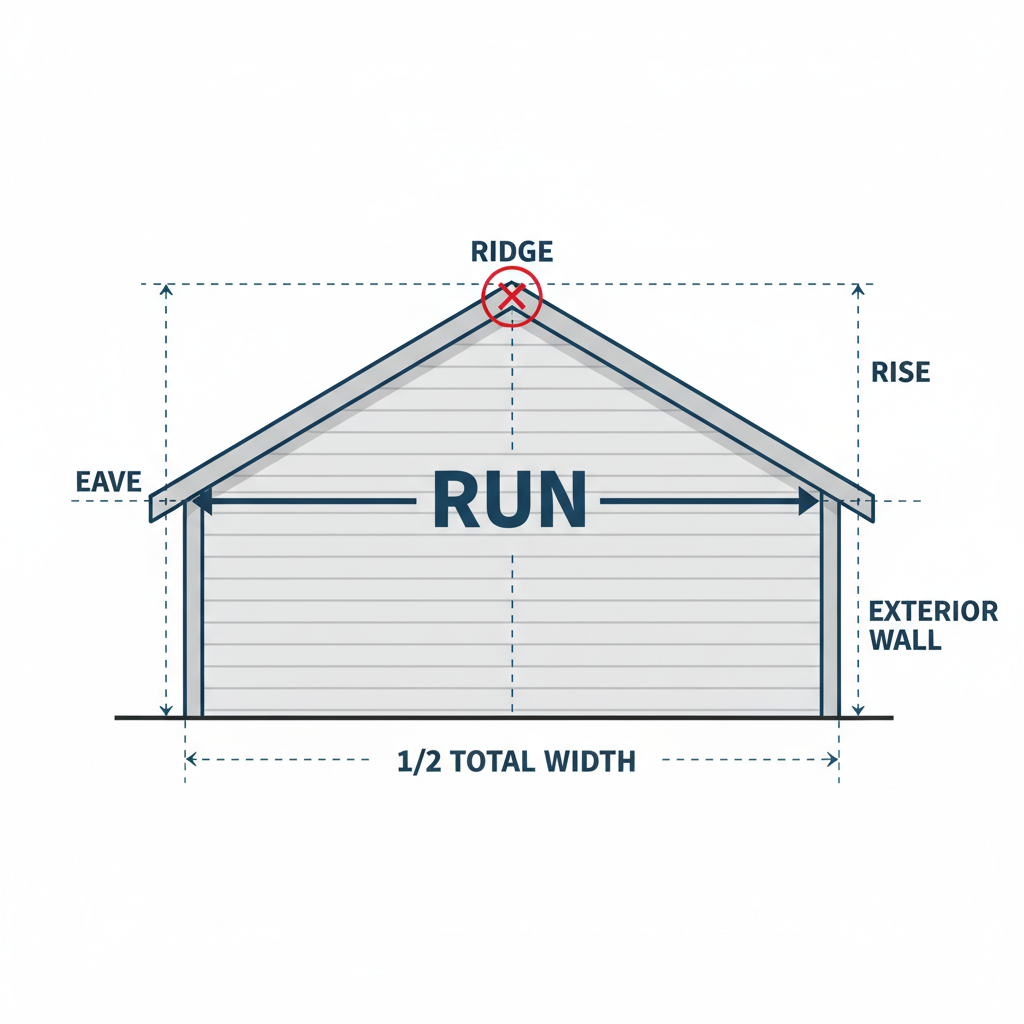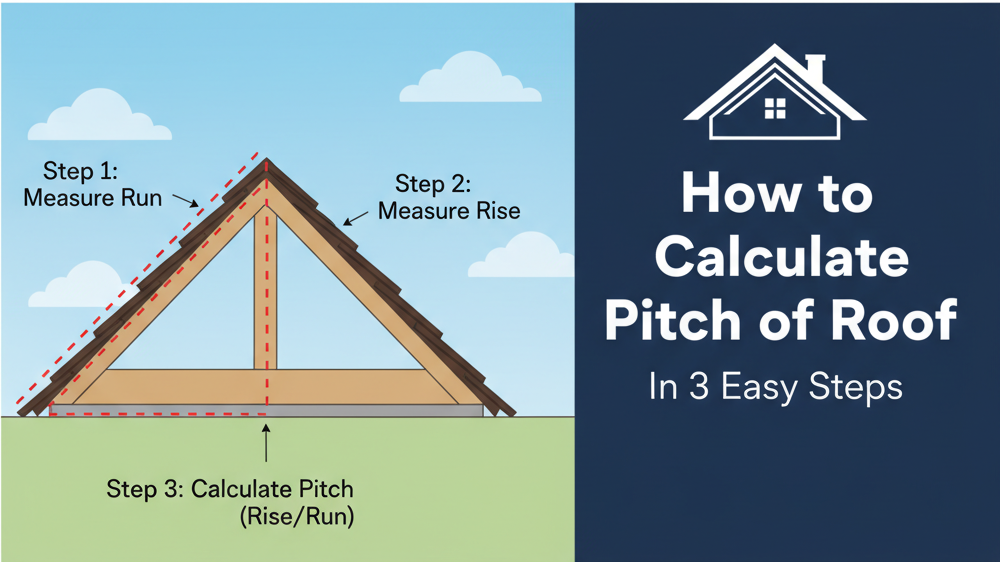For every homeowner, roofer or builder, it’s important to know how to calculate roof pitch. If you are going to install shingles, put up solar panels, or install gutters, knowing the pitch of your roof will help ensure safety, accuracy, and energy efficiency. This professional guide will show you the fool-proof (and professional!) methods with clear, straightforward, applicable steps to calculate roof pitch like a pro – no fancy math degree required!
Table of Contents
What Is Roof Pitch?
The roof pitch denotes the angle or flatness of your roof. Roof pitch is typically expressed as a ratio, such as 4/12, meaning the roof rises 4 inches for every 12 inches of run. When determining pitch of a roof, you are essentially comparing the rise to the run to find its slope.
Roof Pitch Ratio
In simple terms, if a roof has a rise of 6 inches and a run of 12 inches, you have a pitch of 6/12. You can also find the pitch and convert it to degrees using a roof pitch chart or roof pitch calculator.
Types of Roof Pitch
- Low-slope roofs (1/12 to 3/12) – more common in contemporary homes and/or commercial buildings.
- Medium-slope roofs (4/12 to 7/12) – Most of these would fall in the category of residential, which most do.
- High-slope roofs (8/12 and above) – these would sometimes be unusual for residential roofs at this pitch, but for areas that receive snow, a higher pitch is expected to allow snow to fall faster and add capacity for drainage.
Tools You’ll Need to Calculate Pitch of Roof
Before you determine pitch of roof, you will need these tools:
- Tape measure – To measure the rise and run accurately.
- Level – A 12-inch level is the best option.
- Ladder or Roof Access – Always use safety equipment.
- Calculator or Phone – To do some quick math’s for conversions.
You can also use a digital angle finder or roof pitch app which would be optional and allow you to measure roof pitch simpler.
Step-by-Step Guide to Calculate Pitch of Roof

Step 1: Measure the Rise
Safely climb to the edge of the roof. Place the level horizontally on the roof and measure vertically from the level to the roof surface; that’s your rise.
Step 2: Measure the Run
The run is usually 12 inches or 1 foot. You will then compare your rise measurement to this run in order to come up with the ratio.
Step 3: Calculate and Convert
Use the formula:
Pitch = (Rise ÷ Run) × 12
Say, for example, your roof rises 6 inches for every 12 inches of run, then the pitch is 6/12. You can use this same method to calculate pitch of roof for any structure.
Using a Roof Pitch Calculator
With online roof pitch calculators, it couldn’t be easier. Simply enter your rise and run, and the calculator will provide you with your ratio and angle, instantly. This is the quickest and easiest method for determining roof pitch accurately, which is great for estimating materials for roofing projects.
How to Calculate Roof Pitch from the Ground
Even if it isn’t possible to climb onto your roof, do not be discouraged! You can still determine the roof’s pitch from ground level.
- Take a picture of your roof from the gable end.
- Using some reference points, measure the width and height.
- Then, using simple geometry or a mobile app, the slope can be determined.
Roof Pitch Chart and Angle Conversion
| Roof Pitch | Angle (Degrees) |
|---|---|
| 3/12 | 14° |
| 4/12 | 18° |
| 6/12 | 26° |
| 8/12 | 34° |
| 10/12 | 40° |
Why Calculating Roof Pitch Correctly Is Important
- Safety: Ensuring safety of coworkers during roof construction.
- Estimating materials: This allows for either overage or reduces the risk of running out of materials.
- Aesthetics: Ensures the roof design is consistent with the home’s overall visual style.
- Drainage: The steeper a roof is, the better it will perform at shedding water and snow.
Frequent Errors While Measuring Roof Pitch
- Measuring from the incorrect area of the roof
- Disregarding both the eaves or overhangs
- Utilizing a warped-level or not level tape measure
A minor error can disrupt the whole calculate pitch of roof process — verify all of it!!
Real-world Applications of Calculating Roof Pitch
Example 1: If your rise is 4 inches for every 12 inches of run, the roof pitch is 4/12 (moderate slope).
Example 2: If your rise is 8 inches per 12 inches of run, the pitch is 8/12 — good for heavy rain or snowy conditions.
How Roof Pitch Affects Material Choices
In determining pitch of roof, you are determining what materials also suit best:
- Low pitch: Requires materials like rolled roofing or TPO membranes.
- Medium pitch: Asphalt shingles will work great.
- Steep pitch: Metal roofing or slate tiles would be ideal for durability and runoff.
Roof Pitch and Local Building Codes
Building codes often have minimum roof pitch for safety and resisting the weather. For example, snow-heavy areas might require a steeper roof pitch to avoid accumulation of snow. Before calculating pitch of roof for building, be sure to check local codes.
Expert Strategies to Accurately Determine the Pitch of the Roof
- Use a digital tool to read accurately.
- Measure multiple areas of the roof.
- Compare results with a roof pitch calculator to assure accuracy.
Conclusion:-
It doesn’t have to be a difficult process learning how to calculate pitch of roof . With proper knowledge and tools, determining your roofs slope is easy and will allow you to make educated choices with materials, drainage and upkeep. Just remember – accuracy and safety always matter!
FAQs
1. What is the easiest way to calculate roof pitch?
Using either a calculator or a smartphone app will give you quick and accurate results.
2. Can I calculate roof pitch without climbing the roof?
Certainly. The roof pitch can easily be determined by taking measurements or even a few pictures from the ground and using the calculation apps.
3. What’s the ideal roof pitch for heavy rainfall?
You want a roof pitch in the range of 6/12 to 8/12, so that water can flow and not pool on the roof.
4. Does roof pitch affect energy efficiency?
Yes, especially steeper roofs can work to improve ventilation in the attics and reduce heat build-up.
5. How often should I recheck my roof pitch?
As long as you’re not doing any renovating or replacing any of the materials, you should find you only need to calculate the pitch of the roof once.


